| |
�@      |
  �@ �@ |
������̏d�v�ȃA�[�e�B�X�g�̈�l�A�t�B���b�v�E�p���[�m�̓��{���ƂȂ��|����ȓW����ł��B
�p���[�m�̓����́A�f���A�����A�h���[�C���O�A�e�L�X�g�ȂǑ��l�Ȏ�@��p���A�W�������т����ЂƂ̃��f�B�A�Ƃ��đ����Ă��邱�Ƃł��B�܂�W����͈�A�̏o�������W�J�����Ԃł���A�X�̍�i�̈Ӗ��ł͂Ȃ��A�u�I�u�W�F�N�g�v�Ƃ��ēW����̉\����T���Ă����ƁA�W����̓I�[�v���X�y�[�X�ƂȂ�A���ɉ����ĕω�����t�H�[�}�b�g�ƂȂ�܂��B�W����ɖK��邱�Ƃ��A��ԓI�E���ԓI���E�⊴�o�I�o�����B�ꖳ��̑̌��ƂȂ邱�Ƃ�ڎw���Ă���̂ł��B
�{�W�ł́A�p���[�m�̑�\��ł��锒�M�����_�ł���u�}�[�L�[�v��A�V��ɒ�������D�u�����o���v�̂ق��A1995�N�Ƀ��^���E�����p�قƓ`���̃L�����^�[�A�����E�t�[�g���R���{���[�g�����W����u���̔g��W�v�Ő��삵���X�́u�Ⴞ��܁v�����̎p��V�������o�ꂵ�܂��B
���F�����Ȃ����̍�i��ʂ��A�p���[�m�����Ă���ߖ����̕��i���L����̂ł��傤���B�Ő�[�ł���Ȃ�����������A����Ă͏�����s�v�c�ȃp���[�m���[���h�ł��B |
A key artist of his generation, Philippe Parreno has radically redefined the exhibition experience by taking it as a medium, placing its construction at the heart of his process. Working in a diverse range of media including film, sculpture, drawing, and text, Parreno conceives his exhibitions as a scripted space where a series of events unfold. He seeks to transform the exhibition visit into a singular experience that plays with spatial and temporal boundaries and the sensory experience of the visitor. For the artist, the exhibition is less a total work of art than a necessary interdependence that offers an ongoing series of open possibilities.
In this exhibition, you may encount his masterpieces including Marquee made of lightbulbs and neons flickering, and Speech Bubbles which is balloon work stuck to a ceiling. And also Ice Man exhibited in Ripples across the Water in 1995, a exhibition by WATARI-UM collaborated with a legendary curator Jan Hoet, shall get renewed and reappear.
Through these colorless and transparent works, we may witness a neo-futuristic landscape in Parreno's eyes. This is a cutting-edge but also nostalgic, mysterious world of Parreno, which is here today and gone tomorrow.
|
���̓W����́A1994�N����2006�N�ɂ����Đ��삳�ꂽ��i-�I�u�W�F�̃v���[���e�[�V�����A���邢�͍č\���ł���B
�^�C�g���͂����̍�i������ꂽ�N����d�ˍ��킹�Ă���B1994�N�́s����ׂ�t����X�^�[�g���A1995�N�A���^���E�����p�قɂ���悳��A�����E�t�[�g���L�����[�V���������u���̔g��v�W�̂��߂ɐ��삳�ꂽ�s���A���e�B�[�E�p�[�N�̐Ⴞ��܁t�A������2007�N�ɔ��\���ꂽ�ŏ��́s�}�[�L�[�t�܂ŁB
�����̔N�オ�ߓx�ɘI�o���邱�ƂŁA���̃��`�[�t���a�������B
���̃��`�[�t�ɂ��A�^�C�g���Ɂu���v�Ƃ������t���^����ꂽ�B
�����ɋ؏����͂Ȃ��B
�����Ďn�܂���I�����Ȃ��B
�����ŁA�I�u�W�F�����݂͌��ɉ�b���͂��߂�B
���ꂼ��̃I�u�W�F���m�ɂ͊W������B�J������ʂ��āA���^���E�����p�َ��ӂ̋C���╗�̕����Ȃǂׂ̍��ȏo�����ɂ� ��������B���ׂĂ͋�C�̕ω��⊷�C�ɔ������Ă���B �I�u�W�F�����͈ꏏ�ɂȂ��āA�����̏������Ă����B���A2019�N11��1������A��A�̌������������2020�N3��22���܂ŁB
�@
�@�@�@�@�@�@�@�@�@�@�@�@�@�@�@�@�@�@�@�t�B���b�v�E�p���[�m �@
|
This is a presentation or a re-presentation of objects that appeared between 1994 and 2006.
The title is made out of the superposition of all those dates starting in 1994 (The Speaking Stone) or 1995 (The Ice Man In Reality Park that was made for a group exposition called �sRipples across the water�t curated by Jan Hoet that took in WATARI-UM, The Watari Museum of Contemporary Art) and finishing with the first Marquee appearance in 2007.
An over exposure of dates produced this motif.
This motif gives the title a manifestation.
There is no synopsis to this.
There is no beginning and no end to it.
Here objects enter into a dialogue between each others.
Each of these object sees (through a camera) the other connected, and is sensible enough (they have access to data about atmospheric pressure and the wind direction in Shibuya) to react to some precise events. They all react to air variations, to air exchanges.
All together they produces scenes that will occurred between now November 1st 2019 and the completion of this series of manifestations on March 22nd, 2020.
�@�@�@�@�@�@�@�@�@�@�@�@�@�@�@�@�@�@�@�@�@�@Philippe Parreno
|
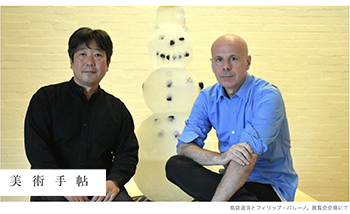 |
|
|
  �@ �@ |
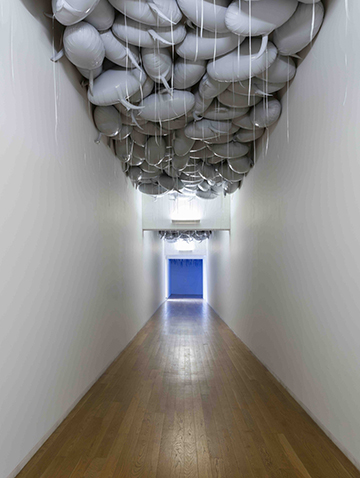
|
�����o���i���j�A
�@
���̃}�C���[�o���[���A�w���E��
|
Speech Bubbles (White), 1997
White
Mylar balloons, helium |
�s�����o���i���j�t�̓t�B���b�v�E�p���[�m�ɂ��s�����o���t�i1997 �N�`�j�V���[�Y�̈��i�ŁA����Ŏg���鐁���o���̌`���������D����Ȃ�܂��B�p���[�m���p���鐁���o���́A����Љ�ł͌���Ȃ����t�ƌ�����ے����Ă��܂��B
�s�����o���i���j�t�͏\����ނ̃J���[�o���G�[�V���������{�V���[�Y�ŏ��̍�i�ł��B�����͘J���g���������D�Ɏ���̃X���[�K���������A�J���g���̃f���Ŏg���邱�Ƃ��\�z����Ă��܂����B���̃A�N�V�����͎��s����܂���ł������A�{��ƌ���Ȃ��l����c�_�Ƃ̊W���͎c���Ă��܂��B
Speech Bubbles (White) is part of the series of Philippe Parreno's Speech Bubbles (1997 - ongoing), which consist of helium filled inflatable balloons cast in the graphic form of the dialogue frame used in comic strips. The visual sign of the speech bubble used by Parreno alludes to the unspoken words and language as a suspended state in contemporary societies. Initially, the Speech Bubbles (White) -the first of the series - were conceived to be used at a labor union demonstration at which unionists were to write their slogans on the balloons. While this action did not take place, the association with unspoken thoughts or discussions remains.
Exhibition view: A Time Coloured Space, Museu Serralves, Porto, 2017
Collection FRAC Grand Large - Hauts-de-France, Dunkirk
Photo © Andrea Rossetti
|
| |
�n�b�s�[�E�G���f�B���O �@
�N���X�^���K���X�A�d�C�n���A������A�X�C�b�`�ƃv���O�i���j
|
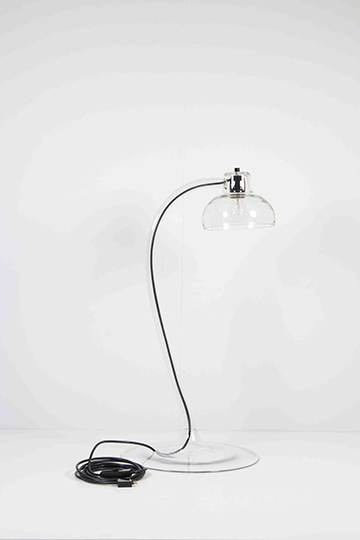
Collection Philippe Parreno, Paris
Photo © Philippe Parreno |
| |
|
�{��̓t�B���b�v�E�p���[�m�ɂ�鏉����i�̕ω��n�ł��B�Ɠ��̎萁���K���X�̃����v�ŁA��i�ɂ�菭�����قȂ�l�b�N�Ɠd�C�R�[�h�����Ă��܂��B���݂̎p�ɂȂ�܂łɓx�X�ω����d�˂Ă���A�{��̂��Ă̎p��S��̂悤�Ɏv���N�������܂��B
���Ƃ��Ƃ�1996�N�A�X�g�b�N�z�����ł̌W�̍ۂɍ\�z����܂����B�p���[�m�͓W���X�y�[�X������ꏊ�ɂ��Čv�悳�ꂽ�z�e���i���݂��ꂸ�j�̂��߂ɃA���l�E���R�u�Z�����f�U�C�����������v��W�����܂����B����ۂȋ�ԂɓW�����ꂽ�����v���A�ꌩ�v���O�͎h�����Ă��Ȃ��̂ɁA�s�v�c�ɂ��_�����Ă���Ƃ������̂ł����B1997�N�̃p���ł̌W�ŁA���̍�i���K���X��p���čĉ��߂��A���R�u�Z���̃����v�Ƃ͑S���Ⴄ�A���݂̎p�ɋ߂���i�\���܂����B����Ɋւ��ăp���[�m�́u�P�ɃC���[�W�̃C���[�W�ł���v�ƌ���Ă��܂��B
Happy Ending is an incarnation of an early work by Philippe Parreno. This is a unique hand-blown glass lamp, part of a series each with a slightly different neck and electrical cord. This work has been reincarnated again, creating a ghostly reminder of the artist's previous exhibitions.
The original work was conceived for his 1996 solo exhibition at Stockholm. On that occasion, Parreno presented a lamp designed by Arne Jacobsen intended for a hotel that would have been located on the exact same site than the Swedish art space; the hotel was never built. The lamp, displayed in an empty space, was mysteriously lit without being visibly plugged in. In 1997, on the occasion of a solo exhibition in Paris, Parreno presented glass reinterpretations of previous works that no longer existed, including the Happy Ending lamp. The glass lamp bared no resemblance to the original model; as explained by the artist "it was simply an image of an image." |
| |
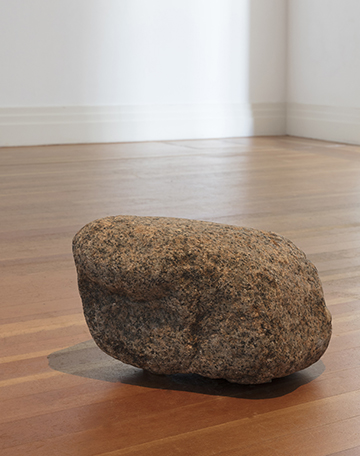
Exhibition view: Philippe Parreno, Gropius Bau,Berlin, 2018
Courtesy the artist; Pilar Corrias, London; Gladstone Gallery, New York and Brussels; EstherSchipper, Berlin �@�@Photo © Andrea Rossetti |
����ׂ�� �@
�l�H�A���C�����X�X�s�[�J�[�V�X�e��
|
La pierre qui parle (The Speaking Stone), 2018
Synthetic stone, wireless speaker system |
���C�����X�X�s�[�J�[����������l�H�������̐^�ɒu����A�t�B���b�v�E�p���[�m���M�A�o�D���㏃�q�̐��i���{��Łj�ɂ��A�I�[�g�}�g���ɂ��Ẵe�L�X�g�����܂��B
�{��̓p���[�m�ɂ��1994 �N�̍�i�s����ׂ�t�̕ω��n�ł��B���c�F�������p�قł̃O���[�v�W�u�o�b�N�X�e�[�W�v�ō\�z����܂����B�I���W�i���ł́s����ׂ�t�́A�W�����E�����b�N�E�S�_�[���̐����܂˂��p���[�m���g�̐��ŁA���w�ƔF�m�Ȋw�ɂ�����\���̏�Ԃɂ��Ă̍u�`��`���Ă��܂����B
A synthetic stone containing a wireless speaker is placed in the center of an empty room and delivers a text on automatons written by Philippe Parreno and read by an actress Junko Murakami (Japanese version).
The work is a new iteration of Parreno's 1994 Speaking Stone, conceived on the occasion of the group exhibition Backstage at Kunstmuseum Luzern. The initial version of the Speaking Stone delivered a lecture on the status of representation in aesthetics and cognitive sciences, read by the artist imitating the voice of Jean-Luc Godard. |
| |
���A���e�B�[�E�p�[�N�̐Ⴞ��� �@
�X�̒���
|
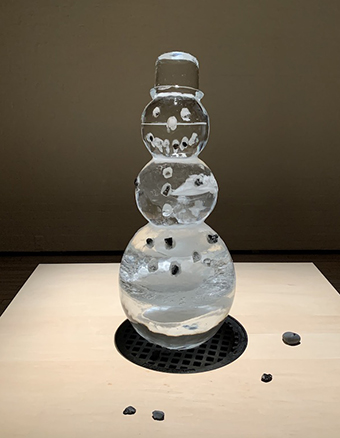 |
Ice Man in Reality Park, 1995- 2019
Sculpted ice |
1995�N�A���^���E�����p�ق��`���̃L�����[�^�[�A�����E�t�[�g���}���A�R�̊X���Ɍ�����p��W�������u���̔g��v�W�̂��߂ɍ��ꂽ��i�ł��B�p���[�m�͎��L�n�ɕs�v�c�Ȓ�����グ�A�X�łł������̐Ⴞ��܂�ݒu���܂����B�X�͎���ɗn���ď����Ă����܂��B�l�����I�Ԃ�̍Č��ƂȂ�܂��B
Ice Man in Reality Park was first created for the 1995 group exhibition Ripple Across the Water — curated by Jan Hoet — which turned Aoyama city center into an outdoor art gallery. Every day just before lunch, in the private park of the Kirin Brewery Company in Minami Aoyama where employees gathered to eat, a refrigerated truck delivered an ice sculpture of a snow man. Every day the sculpture melted and was replaced the next day.
Courtesy the artist and Esther Schipper, Berlin �@Photo © Philippe Parreno |
| |
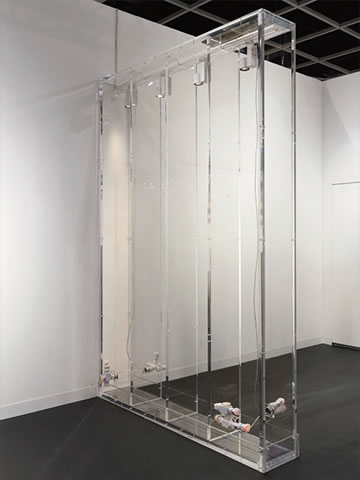
Collection RC Culture and Arts Foundation
|
�ԉł̕� �@
�A�N�����K���X�A�ؖ����[���ALED�X�|�b�g���C�g�A�d�C�v���O�A�d���A�_�v�^
|
Wall for the Bride, 2018
Acrylic glass, copper lighting track, LED spotlights, electric plugs and power adapters |
�����̃A�N�����A�R���s���[�^�[�v���O�����̃R���g���[���̂��Ɩ��ł���LED�X�|�b�g���C�g�A�A�N�����Ɏh����S�{��“AC/DC�w�r”�i�d�C�v���O�Ɠd���A�_�v�^�̏W���́j����Ȃ��i�ł��B
�{��ɂ̓t�B���b�v�E�p���[�m��A���̃A�[�e�B�X�g�̏���i���|���邱�Ƃ��ł��A���f�B�A�Ƃ��Ă̓W��������ݐi�s�`�ŒT������Ƃ����A�p���[�m�̒��S�I�ȃ��`�[�t��̌����Ă��܂��B�p���[�m�ɂ��ƁA�s�ԉł̕ǁt��“��-�q��”�ł��B�t�����X�̓N�w�҃~�V�F���E�Z�[�����������A�N�w�҃u���[�m�E���g�D�[�������W���������̃R���Z�v�g�́A�T�b�J�[�ɂ�����{�[���̂悤�ɁA���瓮����̂Ƃ͂����Ȃ����A���Ă����̂ł����̋q�̂Ƃ������Ȃ����̂��w�������t�ł��B�p���[�m�ɂƂ��ẮA�W���̕����Ƃ̊W������藣���Ȃ��I�u�W�F�Ƃ������݂�\���Ă��܂��B
�{��͂��Ƃ��ƁA�p���[�m���w�������t�B���f���t�B�A���p�قł̃O���[�v�W�u�ԉł̂܂��ŗx��v�i2012�N�j�̂��߂ɍ\�z����܂����B�����̓A�N�����݂̂ŁA�{��̃^�C�g���̗R���ł���f���V�����̊G��s�ԉŁt���|�����Ă��܂����B�`�̓f���V�����̗L���ȍ�i�u��K���X�v�Ƃ��Ă��m����s�ޏ��̓Ɛg�҂����ɂ���ė��ɂ��ꂽ�ԉŁA�������t(1915-23�N) �������Ă��܂��B �@
Wall for the Bride consists of a transparent acrylic corpus that is lit from within by four LED spotlights that flicker alternatively, controlled by a computer program. Four AC/DC Snakes—multiples of electric plugs and power adapters—are plugged directly into the front and back sides of the wall.
The work embodies central motifs of Parreno ongoing exploration of the exhibition as a medium. In the artist’s words, Wall for the Bride is a quasi-object. Originally devised by French philosopher Michel Serres, and then developed by fellow philosopher Bruno Latour, the concept designates for Parreno the existence of objects as inseparable from the relationship to the context in which they are exhibited.
The work was initially conceived for Dancing around the Bride in 2012, a group exhibition at the Philadelphia Museum of Art orchestrated by Parreno. At that time, the wall consisted of a simple acrylic corpus on which was hung a small painting by Marcel Duchamp, Bride (1912), hence giving its title to the work. Formally, Wall for the Bride refers to Duchamp’s famously enigmatic The Bride Stripped Bare by Her Bachelors, Even, also known as The Large Glass (1915-1923). |
| |
�ǎ��}������ �@
�ǎ��ɗӌ����C���N
|
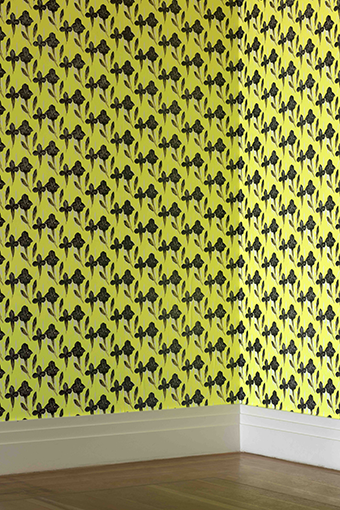
Exhibition view: Philippe Parreno, Gropius Bau,Berlin, 2018
Courtesy the artist; Pilar Corrias, London; Gladstone Gallery, New York and Brussels; Esther Schipper, Berlin�@�@�@�@Photo © Andrea Rossetti |
Wallpaper Marilyn�A2018
Wallpaper with phosphorescent ink |
|
�s�ǎ� �}�������t(2018�N) �̓h�C�c�ŏ��̑�K�͂ȌW�ƂȂ����x�������A�O���s�E�X�E�o�E�ł̓W����̍ۂɍ\�z����܂����B�ǎ��ɕ`����Ă���̂̓A�����̉ԂŁA���ɗӌ����C���N�Ńv�����g����Ă��܂��B����~�ς��A�Èł̒��ŋ��������܂��B
���̕��̓p���[�m�ɂ��2012 �N�̉f����i�s�}�������t�̕���Z�b�g�̔w�i�ɂ��o�ꂵ�Ă��܂��B���̕ǎ���ʂ��āA�s�}�������t�A���̕���Z�b�g�A����ɕ���̃��f���ƂȂ������ۂ̏ꏊ����������Ă��܂��B
�f����i�s�}�������t�́A1950 �N��Ƀ}�������E�������[���Z��ł����j���[���[�N�̃E�H���h���t���A�X�g���A�E�z�e���̃X�C�[�g���[���̃Z�b�g�̒��ŁA�R�̋@�B���S���Ȃ����}�������E�������[�̑��݂��Ăъo�܂��Ƃ������̂ł����B�J�������ޏ��̖ڂƂȂ��Ď��E���f���A�R���s���[�^�[���ޏ��̐��̃��Y���A�A�N�Z���g�A�C���g�l�[�V�������č\�z���A���{�b�g���M�Ղ��Č����܂��B�p���[�m�́A�}�������E�������[�̃m�[�g�̒f�Ђ��W�߂��{�ŁA�������[�̎菑���̕����������Ƃ��A���̃v���W�F�N�g���v�������ƋL���Ă��܂��B
Wallpaper Marilyn was conceived by Philippe Parreno on the occasion of his first major solo exhibition in Germany, at the Gropius Bau in Berlin. The wallpaper depicts irises, printed with phosphorescent ink on paper. It charges light and glows intensely in the dark.As the time goes by. the glow of phosphorescent ink gradually fades.
The pattern was previously seen as a background element in the set of the artist’s 2012 film Marilyn, which conjures up the presence of Marilyn Monroe in the set of a suite at the Waldorf Astoria Hotel in New York, where the actress lived in the 1950s. |
| |
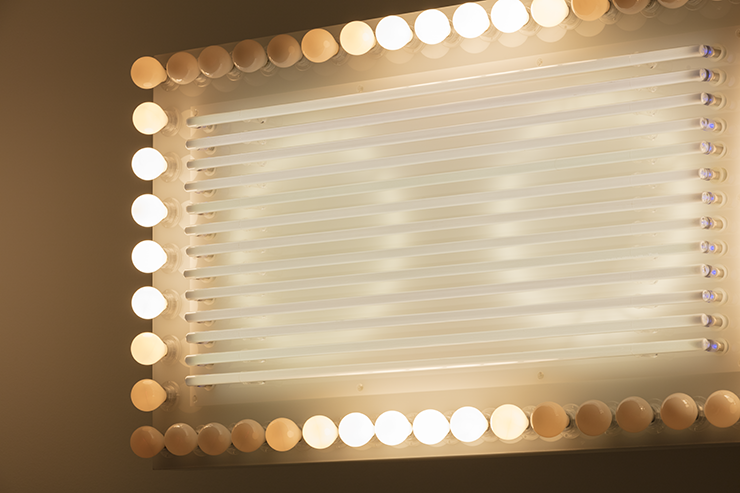 |
�}�[�L�[�@
�������̃v���L�V�O���X�A�d���A�l�I���ǁADMX���R�[�_�[�A������
|
Marquee, 2016
Opaque Plexiglas, lightbulbs, neon tubes, DMX recorder, dimmers |
�t�B���b�v�E�p���[�m�́s�}�[�L�[�t��2006�N�Ɏn�܂����V���[�Y�ŁA��i�̐��͌��݂܂ł�50�ȏ�ɂ̂ڂ�܂��B��i�ɂ��`����̓����͗l�X�ŁA�{�V���[�Y�ŗp�����Ă���A�p���[�m���v���O�������ADMX���R�[�_�[���R���g���[������Ɩ��v���O�����́A��i���d�˂邲�Ƃɔ��W���Â��Ă��܂��B
�{��́A���M�d����l�I���ǂƂ�����������̏Ɩ��Z�p�ƁA�ŐV�̋@�B�Ǝ�@�ō��ꂽ�ߑ�I�ȃA�N�����A�R���s���[�^�[�v���O������g�ݍ��킹�Ă��܂��B�Q���̔������̃A�N�����ɐݒu���ꂽ�d���A13�{�̃l�I���ǁA�Q�̉~�`�l�I���́A�Ƃ��Ɍċz�튯�̂悤�Ƀt�F�[�h�C���E�A�E�g���A�Ƃ��Ɍ������_�ł��܂��B
���������}�[�L�[�Ƃ�20���I�����ɓo�ꂵ���f��ق⌀��̃G���g�����X�ɐݒu���ꂽ���M�����_�ł���݂ŁA�f��̃^�C�g������҂̖��O��m�点�Ă��܂����B�p���[�m�́s�}�[�L�[�t�̖ʂɂ͕����͂Ȃ��A�W����̕����Ɗӏ҂̑z���͂ɉ����ėl�X�ȈӖ��������܂��B
|
Philippe Parreno's Marquee belongs to an ongoing body of work started in 2006 that consists of more than 50 existing marquees to date. It is also part of a new development inside the series that includes multiple lighting programs composed by the artist and controlled by a DMX recorder.
Parreno's Marquees are unique pieces, individual in their form, light effect and construction. The artist's Marquees combine lighting techniques that are almost a thing of the past (such as incandescent bulbs and neon tubes) with modern acrylics that are milled, shaped and formed according to the latest fabrication methods. Marquees first appeared at the beginning of the 20th century. The glowing, flickering porch roofs in front of entrances to cinemas and theaters were announcing movie titles and names of actors. Placed over the entrance of a gallery a Marquee by Philippe Parreno usually announces an exhibition event or a performance that takes place at the venue. The light-lit planes of the Marquees carry no text, thus the works play with a level of abstraction and acquire a different meaning according to the context of an exhibition and imagination of the viewer.
|
|
�@ 
|
| |
�p���[�m�̓t�����X�A�p���ɋ��_�������A���E���œW����Əo�ł��s�Ȃ��Ă���B�����1983�N����1988�N�O���m�[�u���̃G�R�[���E�f�E�{�U�[���ɂāA1988�N����1989�N�̓p���̃p���E�h�E�g�[�L���[ Institut des Haute Etudes en arts plastiques �Ŋw��ł���B
2006�N�@�f��u�W�_���F�_���������j�v���ē�
�@�@�@�@ �i�_�O���X�E�S�[�h���Ƃ̋�����i�j
2013�N�@�W�uAnywhere, Anywhere Out of the World�v
�@�@�@�@
�i�p���E�h�E�g�[�L���[�A�p���j
2015�N�@�W�uH {N)Y P N(Y} OSIS�v
�@�@�@�@
�i�p�[�N�E�A�x�j���[�E�A�[�����[�A�j���[���[�N�j
2016�N�@�R�~�b�V������i�u�q�����_�C�E�R�~�b�V�����E
�@�@�@�@
���ł��v�i�e�[�g�E���_���E�^�[�r���z�[���A�����h���j
2017�N�@�W�u�V���N���j�V�e�B�v
�@�@�@�@
�i���b�N�o���h�E�A�[�g�~���[�W�A���A��C�j
2018�N�@�W�u�t�B���b�v�E�p���[�m�v
�@�@�@�@
�i�O���s�E�X�E�o�E�A�x�������j
���F�l�`�A�E�r�G���i�[���ւ̎Q��
�@�@�@�@�i1993,1995,2005,2007,2009,2015,2017�N�j |
lBased in Paris, France, Parreno has exhibited and published internationally. He studied at the Ecole des Beaux-Arts in Grenoble from 1983 until 1988 and at the Institut des Hautes Etudes en arts plastiques at the Palais de Tokyo, Paris from 1988 until 1989.
2006 film "Zidane: A 21st Century Portrait" (collaboration work with Douglas Gordon
)
2013 solo exhibition "Anywhere, Anywhere Out of the World" (Palais de Tokyo, Paris).
2015 solo exhibition "H {N Y P N Y} OSIS" (Park Avenue Armory, New York).
2016 "Hyundai Commission: Anywhen" (Tate Modern's Turbine Hall, London).
2017 solo exhibition "Synchronicity" (Rockbund Art Museum, Shanghai).
2018 solo exhibition "Philippe Parreno" (Gropius Bau, Berlin).
His work was also presented at the Venice Biennale (1993, 1995, 2005, 2007, 2009, 2015, and 2017).
|
|
|
| |
�p���[�m��2016�N�A�����h���̃e�[�g���_���E�^�[�r���z�[���ōs����q�����_�C�E�R�~�b�V�����ɑI��i�u�q�����_�C�E�R�~�b�V���F���ł�(Anywhen)�v�q1�r�j�A���E�I�Ȑ�^���܂����B2013�N�ɂ̓p���̃p���E�h�E�g�[�L���[�ő�K�͌W�u���̐��̊O�Ȃ�ǂ��ւł�(Anywhere, Anywhere Out of the World)�v�q2�r���J�Â��A2��2000���ẴM�������[�X�y�[�X�S�̂����߂Ďg�����A�[�e�B�X�g�ƂȂ�܂����B
2006�N�A�A�[�e�B�X�g�̃_�O���X�E�S�[�h���Ƌ����ē߂���v�f����i�u�W�_�� �_���������j(Zidane: A 21st Century Portrait)�v�q3�r����66��J���k���ۉf��ՂŃv���~�A��f����܂����B
���Ԃ̓p���[�m�ɂƂ��Ĕ��ɏd�v�Ȃ��̂ł��B2015�N�A�j���[���[�N�̃p�[�N�A�x�j���[�E�A�[�����[�̃E�F�C�h�E�g���v�\���E�h�����E�z�[���ŊJ�Â��ꂽ�W����uH {N)Y P N(Y} OSIS�v�q4�r�́A�����ɉ��o�������A���A�v���W�F�N�V�����A�p�t�H�[�}���X�A���T�C�^�����������Ă����Ƃ������̂ł����B�Ƃ��Ɂu�v���I�v�ƕ\�������p���[�m�̓W����́A��莞�ԑ����Ƃ����W����̈ꑤ�ʂ����߂�v�f�i���̒����A�f���A���y��i�j�����A�ӏ҂̑��x�����߁A�Ƃ��ɍ��点�A���ꂼ��̍�i�ɏW������悤�ɑ����A�Ō�ɂ͊e�v�f���݂��ɊW�����Ă����܂��B |
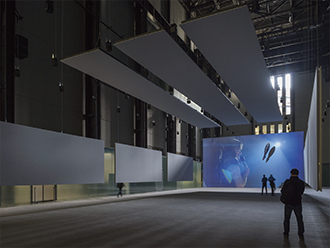
1)�u�q�����_�C�E�R�~�b�V�����F���ł��v�e�[�g���_���E�^�[�r���z�[��2016
|
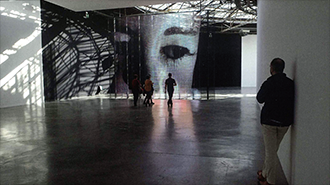
2)�u���̐��̊O�Ȃ�ǂ��ւł��v�p���E�h�E�g�[�L���[ 2013�N
|
2013�N�́u���̐��̊O�Ȃ�ǂ��ւł��v�W�q2�r�Ńp���[�m�́A�p���̃p���E�h�E�g�[�L���[�̋���ȋ�ԑS�̂����{�I�ɕς��Ă悢�Ƃ������S�Ȏ��R��^�����܂����B�p���[�m�͊e�v�f�����I�ɍ\�����A�W�����”�ҋ�”���܂����B�I�u�W�F�N�g�A���y�A���A�f���Ƃ������H��̂悤�ȑ��݂��ӏܑ̌����đ���A�V���̍�i�ւƗ��������A���m���[�O�𑽐����y�ւƕς��܂����B�������̂��̂��A�������A�i�����Â���L�@�̂ɕς����̂ł��B
�J�����X�E�o�V���A���h�ƃG���J�EF�E�o�g�����L�����[�V���������t�B���f���t�B�A���p�قł́u�ԉł̂܂��ŗx��v(2012�N)�ł́A�W�����E�P�[�W�A�}�[�X�E�J�j���O�n���A�W���X�p�[�E�W���[���Y�A�}���Z���E�f���V������̍�i�̂܂��ɁA�p���[�m�͎��ԂƓ��������o���܂����B2010�N�A�T�[�y���^�C���E�M�������[�ł́u�t�B���b�v�E�p���[�m�v�W�ł́A�ӏ҂̓O���[�v�ɂȂ��āA�T�E���h�g���b�N�ɏ]���ĕ������畔���ւƓ����܂����B2013�N�̃����h���A�o�[�r�J���ł́u�ԉłƉԖ��v�W�ł��A���͍Ăю�ȗv�f�ƂȂ�܂����B�P�[�W�A�J�j���O�n���A�W���[���Y�A���E�V�F���o�[�O�A�f���V�����̍�i�̂܂��ŁA�p���[�m���@�ׂɕҐ������A���́A���邢�͎��O�^�����ꂽ�����l�X�ɑ������A���̃_���X�p�t�H�[�}���X�Ƌ��ɕҐ�����A�W��������x���ω������܂����B |
�R���{���[�V�����̓p���[�m��i�ɕs���ł��B2006�N6���A���j�o�[�T���̓p���[�m�ƃX�R�b�g�����h�̃A�[�e�B�X�g�A�_�O���X�E�S�[�h�����ē������҉f��u�W�_�� �_���������j�v�q3�r�����J2006�N�̃J���k���ۉf��ՂŃv���~�A��f����܂����B���̃��j�[�N�ȃT�b�J�[�f���17�@�̃J������p���A8���l�̃t�@�����W�܂����T���e�B�A�S�E�x���i�x�E�E�X�^�W�A���ł̃��A���E�}�h���[�h�r�W�����A������܂邲�ƒʂ��āA�`���I�ȃt�����X�̃~�b�h�t�B���_�[�A�W�l�f�B�[�k�E�W�_����ǂ������̂ł��B2007�N�A�p���[�m���f�B���N�^�[���n���X�E�E�����b�q�E�I�u���X�g�Ƃ̋����L�����[�^�[�߂��O���[�v�W�u�X�֔z�B���̎��ԁv�̓}���`�F�X�^�[���ی|�p�Ղ̂��߂ɐ��삳��A�̂�2009�N�ɃA�[�g�E�o�[�[���ł��J�Â���܂����B�o�C�G���[���c�ƃV�A�^�[�o�[�[���ɂ����ŁA����̃X�e�[�W�ň�A�ɓW�����ꂽ���ԃx�[�X�̃A�[�g��������ȂǁA��Ԃ������Ԃ��߂�O���[�v�W�Ƃ��čl�Ă���܂����B���̃��j�[�N�ȃO���[�v�W�͎��ԃx�[�X�̍�i�ɏœ_�Ă邱�ƂŁA�r�W���A���A�[�g���ǂ̂悤�ɑ̌����ꂤ�邩���`���邱�Ƃ�ڎw���Ă��܂����B
|
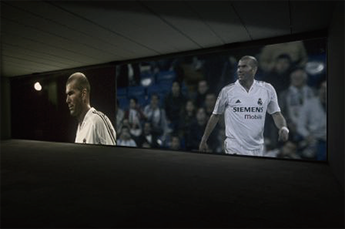
3) �f����i�u�W�_�� �_���������j�v�_�O���X�E�S�[�h���Ƌ����ē@2006 |
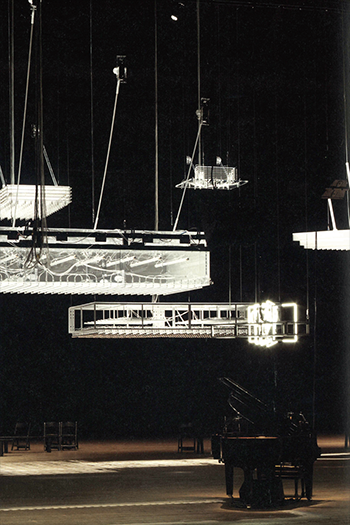
|
2012�N�A�p���[�m�̓A�[�e�B�X�g�A���A���E�M���b�N�ƃR���{���[�V�������A
�u�r�[�`��ʂ��Č��܂Łv�𐧍삵�܂����B�A�����̃A���t�B�V�A�^�[�œW�����ꂽ�{��́A�d���A���Y�A�ω��Ɋւ����i�ŁA�^�C�g���͂��̕ω����鐫���Ɨ��̌��܂蕶�傩��t�����Ă��܂��B�W����ɓ��ꂷ��ƁA�ӏ҂͑�ʂ̍��ŕ���ꂽ�G���A�ɏo���킵�܂��B�S���Ԃ����āA���́u�r�[�`�v�G���A�͍��̒����Ƃɂ�茎�̕��i�ɕς����A22�l�̃A�[�e�B�X�g�̃v���W�F�N�g�̂��߂̕ω����Â���w�i�ƂȂ�܂����B���̃v���Z�X�S�̂́A����A�W���A�A�C�f�A�̌����Ɠ������d�v���Ƃ��āA���J����܂����B
2014�N�ALUMA�A�����L�����p�X�ł́u�\�����X�E�N���j�N���v�W�Ńp���[�m�́A�e�B�m�E�Z�[�K���A�M���b�N�A�n���X�E�E�����b�q�E�I�u���X�g�A�A�T�h�E���U�A�s�G�[���E�u���牽�l���̃A�[�e�B�X�g��L�����[�^�[�ƃ��j�[�N�ȃR���{���[�V���������A�L�����[�^�[�����߂܂����B���̓W�����2���ɂ킽��J�Â���A�A�[�e�B�X�g�ɂ���A�̉���ƃv���W�F�N�g��ʂ��āA���z�ƃt�����N�E�Q�[���[�̑n���I�ȃr�W�����͂��܂����B�Q�[���[�ɂ��Ƒn�I�ȍ�i�Q�̑�X�P�[���̖͌^�𒆐S�ɁA�A�[�e�B�X�g���������삵���ω��������鉉�o���A�A�[�g�ƌ��z�̊Ԃɋ��������A�Q�҂̈�ʓI�ȊW�ƃR���{���[�V�����̃v���Z�X��ϗe�����܂����B
�p���[�m�̓t�����X�A�p���ɋ��_�������A���E���œW���A�o�Ŋ������s���Ă��܂��B�ނ�1983�N����1988�N�ɃO���m�[�u���̃G�R�[���E�f�E�{�U�[���ɂāA1988�N����1989�N�Ƀp���̃p���E�h�E�g�[�L���[��Institut des Haute Etudes en artsplastiques�Ŋw�т܂����B
�p���[�m�͈ȉ��̔��p�قŌW���J�Â��Ă��܂����B�x�������̃O���s�E�X�E�o�E(2018�N)�A��C�̃��b�N�o���h�E�A�[�g�~���[�W�A��(2017�N)�A�|���g�̃Z�������F�X������p��(2017�N)�A�����{������ACMI(2016/17�N)�A�~���m�̃n���K�[�r�R�b�J(2015/16�N)�A�j���[���[�N�̃p�[�N�A�x�j���[�E�A�[�����[(2015�N)�A�p���̃p���E�h�E�g�[�L���[(2014/13�N)�ACAC �}���K(2014�N)�A���X�N���̃K���[�W������p��(2013�N)�A���[�G���^�o�[�[���̃o�C�G���[���c(2010-11�N)�A�j���[���[�N�A�o�[�h�E�J���b�W�̃L�����[�^�[�����Z���^�[(2009-10�N)�A�_�u�����̃A�C�������h�ߑ���p��(2009�N)�A�N���X�g�n���E�`���[���b�q(2009�N)�A�p���̃|���s�h�D�[�E�Z���^�[(2009�N)�B�p���[�m�̍�i�͈ȉ��̐��X�̑�K�͂Ȕ��p�ق̃R���N�V�����ł�����܂��B�����h���̃e�[�g�A�j���[���[�N��MoMA�A�p���̃|���s�h�D�[�E�Z���^�[�A�j���[���[�N�̃O�b�Q���n�C�����p�فA���{�̋���21���I���p�فA�p���̃p���s���ߑ���p�فA�T���t�����V�X�R��SFMOMA�A�~�l�A�|���X�̃E�H�[�J�[�A�[�g�Z���^�[�ȂǁB�ނ̍�i�̓x�j�X�r�G���i�[��(1993, 1995, 2005, 2007, 2009, 2015,2017�N)�A�x�j�X���z�r�G���i�[��(1997, 2003, 2005�N)�A�C�X�^���u���E�r�G���i�[��(2001�N)�ł��W������܂����B |
|
  �@ �@ |
| |
  �@ �@ |
|
|



